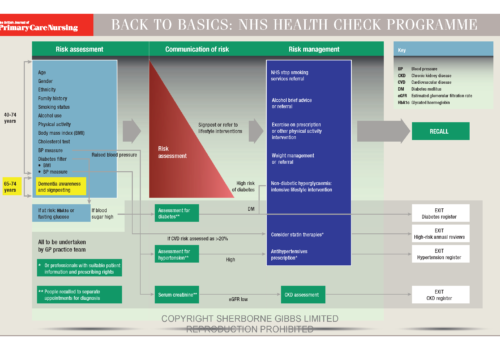The NHS Health Check offers 15 million people aged 40-74 years in England an assessment of cardiovascular risk, together with preventive interventions, once every five years. The programme has aroused some controversy, but there is an urgent need to take action now to reduce preventable, premature death and disability caused by vascular disease.
Feeling good? Long-term conditions and psychological health
Compared with the rest of the population, people with long-term conditions—especially cardiovascular disease, diabetes, chronic obstructive pulmonary disease (COPD) and musculoskeletal disorders—have two to three times the risk of experiencing a mental health problem. In this article we will consider how these issues affect long-term conditions, how we can assess their impact and how we can improve the psychological wellbeing of these patients.
The Eatwell Plate: Helping patients get the balance right
There are many fads about specific foods and their ‘super’ vitamins and minerals. Our choice of foods has also widened as supermarkets expand their ranges and previously specialist foods become mainstream. However, even though we can now buy tamarillos, Christmas-cake cheese or cranberry and pecan bread, the principle of proportion remains consistent. So the Eatwell Plate is very helpful in showing patients exactly what we mean when we advise them to follow a ‘healthy, balanced diet’.
Catching the sun: The facts about vitamin D
The last decade has witnessed an explosion of interest in vitamin D. The vitamin has an established role in promoting bone health, but should we be routinely testing vitamin D levels in our patients? And what is the evidence that supplementation improves health beyond the skeleton?
Let’s talk about sex to men with diabetes
Erectile dysfunction (ED) is three to four times more common in men with diabetes, and 20% have the condition at diagnosis. ED is a marker for heart disease, and men themselves value the opportunity to discuss their sexual problems with a health professional. The annual diabetes review offers the opportunity to identify and treat these men. Some practice nurses may find this task daunting, but treatment of ED can help to improve a man’s wellbeing and reduce his cardiovascular risk.
Editorial
I was listening to the radio the other morning as the news was breaking that polyunsaturated fats seem to be no better for your heart than good old butter. My friend Mike Knapton from the British Heart Foundation was interviewed and in his radio clip he said: “Choose something for taste and texture!” Now I would bet my life savings, if I had any, that he was edited, and that he would have gone on to advise moderation in all things and that it is important to reduce the amount of fat in the diet.
JBS3: A ‘heart age’ approach to cardiovascular risk
The long-awaited Joint British Societies’ consensus recommendations for the prevention of cardiovascular disease (JBS3) were issued at the end of March.
Back to Basics: NHS Health Check Programme
The management of familial hypercholesterolaemia
Homozygous familial hypercholesterolaemia (FH) is a rare disorder with a very high risk of premature cardiac death that must be diagnosed and treated from childhood onwards, usually with lifelong lipoprotein apheresis. Heterozygous FH is much commoner, with a high risk of cardiovascular disease in adults that can be prevented by early diagnosis and statin therapy.
HEART UK – The Cholesterol Charity – has provided editorial support and review of this sponsored FH series.This article was made possible by an unrestricted educational grant by Sanofi, who had no control over content.
How to eat well if your appetite is poor
www.leedscommunityhealthcare.nhs.uk
Food first: supporting adults with poor appetites
Malnutrition is a cause and consequence of disease, and affects at least 3 million adults in the UK, most of whom live in the community. By helping these vulnerable patients to eat the right types of food rather than use inappropriate supplements, practice nurses can not only help prevent and treat malnutrition, but also save the NHS millions of pounds each year.
Why and when to test for anaemia
In primary care, sending blood samples to the laboratory is so routine that it is easy to take these tests for granted. But it is important to understand the purpose of each test; when it is appropriate; and how to act on the results. Here red blood cell tests and their role in identifying possible causes for anaemia are discussed.





















